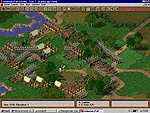 |
|
|
|||||||||||||
 Interactive Magic’s North vs. South is a
brigade-level turn-based game that covers ten battles from the Eastern theatre of the
American Civil War. The battles range from the major, like Gettysburg and Antietam, to the
relatively minor, like Cedar Mountain and Brandy Station. The game is the most recent in
Interactive Magic’s and Erudite ‘s Great Battles series, a collection whose
previous games focused on the great captains of the classical world--Alexander, Hannibal,
and Caesar. Interactive Magic’s North vs. South is a
brigade-level turn-based game that covers ten battles from the Eastern theatre of the
American Civil War. The battles range from the major, like Gettysburg and Antietam, to the
relatively minor, like Cedar Mountain and Brandy Station. The game is the most recent in
Interactive Magic’s and Erudite ‘s Great Battles series, a collection whose
previous games focused on the great captains of the classical world--Alexander, Hannibal,
and Caesar. Now, even if you don’t know much about history, you probably know that there’s quite the temporal gap between, say, Cannae and Bull Run. And you might even recognize that the organization, tactics, and weapons of, say, the Theban Sacred Band and the Iron Brigade were significantly different. And if you are a truly gifted lad, you might even extrapolate from this that two tactical/operational wargames from these two eras, called, say, The Great Battles of Alexander and North vs. South, might need two different game systems. And in fact you’d be right; even back in the dark (or golden, take your pick) ages of the early seventies S&T recognized that the game system for its classical PRESTAGS (anyone remember what that acronym stood for?) tactical games had to be different than the one for its rifle and musket games. This fairly elementary insight seems to have been lost upon North vs. South, which pretty much grafts the GB system right onto the Civil War, with predictably problematic results.
This actually works pretty well on the classical battlefield, where numbers were an iffy thing and casualties proportionally lighter than they are in the post-gunpowder era. But it just doesn’t work for the Civil War. For instance, at Antietam, Hood lost over three-fourths of his command in the vicious fighting at the cornfield. When asked later where his command was, he replied, "Dead on the field." There’s not much chance of rallying dead troops, and while morale was of course important to units in the Civil War, it pales in comparison to the sheer damage units sustained from concentrated fire. Which, by the way, is vastly underpowered in the game. Most of your combats will be decided by melee; fire is a nuisance, but your troops won’t get chopped to pieces by enemy rifles and cannon. In fact, the game plays like the earlier games, only with all the heavy infantry armed with slings. It just doesn’t feel like ACW combat.
I’ve grown increasingly disenchanted with the Great Battles series. I admired and enjoyed Alexander, thought that Hannibal was the high-water mark of the series (even though the lack of graphical improvement was a drag) and thought that Caesar was competent but just not much fun (due mostly to the machine-like qualities of the late Roman army). North vs. South demonstrates nothing so much as a game system sinking towards its nadir. Shoehorning a Civil War game into an Ancients game system is a misbegotten idea, and the lack of any real improvement or modification to the game system after three years is distressing. Do yourself a favor, and skip this one. If you really need to play a Civil War game, pick up either one of the turn-based Talonsoft Battleground bundles or a copy of the real-time Sid Meier’s Gettysburg! |